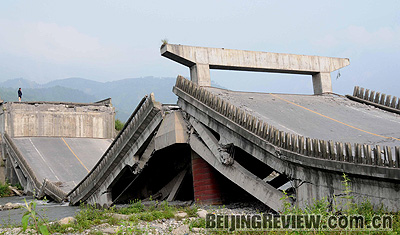|

CRUMPLED CONCRETE: A bridge in one of the worst-hit areas in Pengzhou city, Sichuan Province, collapses like a deck of cards after the strong quake
The China Earthquake Administration (CEA) formally announced on May 18 that it had revised the magnitude of the earthquake that struck southwest China's Sichuan Province on May 12 from 7.8 to 8.0 on the Richter scale. It based the upgrade on additional statistics provided by monitoring stations at home and references from overseas seismological observatories.
It is the second revision of the CEA on the magnitude of the Sichuan earthquake. The bureau first reported the magnitude as 7.6 shortly after the quake hit Wenchuan County, the epicenter, on May 12, which was upgraded shortly after to 7.8.
"It is very common to revise the magnitude of a major earthquake," Xiu Jigang, Deputy Director of CEA, told Xinhua News Agency.
According to Xiu, to report the magnitude of an earthquake as quickly as possible to let the public know the necessary information in time, seismological institutes will often release a measurement of the magnitude based on data from a limited number of measuring stations first. This will be followed by more recent data and the participation of additional observation stations, making the measurement of the magnitude more accurate.
"So, the magnitude revision of the May 12 earthquake in Sichuan, which is a strong quake, is carried out gradually and is a common practice," said Xiu.
Other countries also measured the Sichuan earthquake. Scientists from the United States first put the magnitude of the tremor at 7.8 and then revised it to 7.9, while their counterparts in Europe revised it from 7.5 to 7.9, and Russia set it at 8.0.
"The revision of the magnitude of the May 12 earthquake to 8.0 is well-founded," said Chen Yong, one of academicians of the Chinese Academy of Sciences, in an article on csi.ac.cn, a Beijing-based website on seismological information.
He said that according to his research on the statistics of the Sichuan quake released by an authoritative German earthquake observation station, he found that the swing of seismic waves of the Sichuan quake was higher than that of the 7.6-magnitude earthquake in north China's Tangshan City, Hebei Province, in 1976, which claimed more than 200,000 lives. "This is proof that the Sichuan earthquake this year is stronger than the tremor in Tangshan," he said.
Previously, Chinese scientists had said that the intensity of the Sichuan quake was bigger than the Tangshan quake in 1976. They explained that because the quake in Tangshan occurred at night when most people were asleep and the epicenter was in a city, victims then were more vulnerable than in the Sichuan quake, which happened during working hours and hit a mountain area.
Chinese geologists said that the quake in Sichuan caused serious damage to buildings, bridges and other public facilities in an area of more than 100,000 square km.
Shocked and saddened by the devastating earthquake, some netizens in China said on the Internet that the CEA should have predicted the quake in advance. A photo allegedly taken in southwest China's Chongqing Municipality, east of Sichuan Province, is posted on the Internet, showing thousands of frogs crossing a road. Many netizens claimed that it might be evidence of an impending disaster.
But seismologists soon cleared the query and concern among the public. Zhang Guomin, a research fellow with the Institute of Earthquake Science under the CEA, said on May 14 that earthquake forecasts should be based on scientific analysis and no seismological authorities in any country could accurately predict earthquakes today.
Three factors combined to make earthquake forecasting one of the most difficult tasks around the globe, according to Zhang Xiaodong, Deputy Director of the China Earthquake Networks Center. He made the remark at a press conference organized by the State Council Information Office on May 13.
These factors include the constant difficulty of predicting what is happening underground by making observations on the surface about the complicated process of earthquake formation; additional dynamics, such as geographical conditions, historical time factors and the magnitude of earthquakes; and the low statistical probability of earthquake occurrences. Together these make earthquakes harder to predict, although they occur around the world every year and some are very strong.
| 